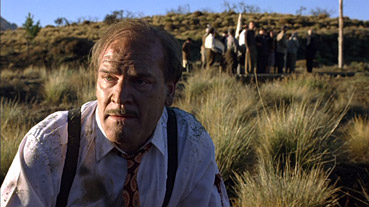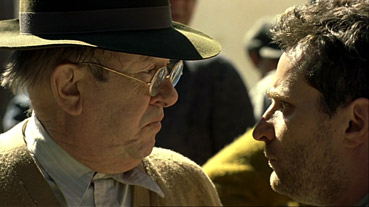|
Wearing
a title that sounds like a melding of sub-Sergio Leone spaghetti
western and Carry-On style British silliness, To Die
in San Hilario is a low-key comedy that starts
rather well and drifts along at an engagingly casual pace,
then follows a too predictable path that ultimately tips
over into sentimentality.
A straightforward set-up informs us that the small town of
San Hilario was once renowned for the splendour of its funerals,
but in the past ten years trade has tapered off. Out of
the blue, a letter arrives informing the townspeople that
a man named Germán Cortes, who grew up in the town
but left to become a successful painter, is returning with
the intention of dying there and being buried in the style
he remembers from his youth. For the town this is a big
deal, a chance to perhaps revive their dormant speciality.

Once
this has been explained, things get a little more intriguing,
as we flit between stories and watch with bemusement as
a man interrupts his suicide attempt to jot down a suddenly occurred thought, and a priest breaks off from his
agitated prayers to smash up a statue of Saint Benedict.
And then there's 'Piernas' ('Legs') Germán, a gangster
who escapes a shoot-out with a bagful of money and hops
into a freight car on a train heading towards...well, you've
guessed it. On board the same train is Mr. Cortes, but despite
his determination to die at his chosen location, he pegs
out en route. All prepared for Cortes and having no idea what
he looks like, the San Hilario residents thus assumed that the
bemused Piernas is the renowned painter they have been expecting. What
follows will hold few surprises for the seasoned viewer,
as the villagers prepare for the funeral of a man who doesn't
realise just why he is the centre of attention. Ordered
to stay put by his boss until the heat dies down, he plays
up to a role he is learning on the hoof, which all goes
well enough until he is expected, as his final artistic
act, to paint
a mural on the church wall.
The
gentle eccentricity of the town and its locals lends these
scenes a charm and humour that is undeniably engaging. There
are no big jokes, just small, smile-raising moments: the
cheery but twitchy enthusiasm of town governor Mariano;
the "room with a view" that overlooks the graveyard; the map
that locates the town in the middle of a big white space
of nothingness; Piernas's childishly crude mural that is
mistaken for abstract symbolism and admired for its purity.
But
once Piernas realises what is happening and begins to warm
to the town and its residents, the film's charm starts to
wane. Piernas learns some life lessons, falls for the girl,
engages with her kid, and finds he can express himself through
art. It's all very familiar stuff – gangsters who suddenly
discover their sensitive side are like whores with a heart
of gold, cinematic clichés that require a very deft
hand and an original slant to deliver any narrative surprises,
and Legs Germán, well enough played though he is
by Lluís Homar, just doesn't have it.

As
the aspects that provide the initial hook unravel and engaging
eccentricity is revealed to be a symptom of an inner pain that
Piernas's newly discovered good nature can help cure, my
smiles gave way to the sound of air being sucked
through closed teeth. Pretty much every twist in the tale
can be seen coming because you've seen it all before, to
the degree that you should be able to easily predict how all this will
end even before you reach the halfway mark.
Ultimately,
To Die in San Hilario lacks ambition and
bite and retreads well-worn and somewhat flimsy turf without
creating substantial new footprints of its own. Despite
the disappointment of their last two films, I couldn't help
but wonder what Joel and Ethan Coen might have done with
the same basic premise.
No
complaints with the transfer – 1.78:1 and anamorphically
enhanced, the picture displays good contrast and colour
and a pleasing level of detail, without obvious edge enhancement.
Dolby
5.1 and DTS surround options are offered, the DTS being
slightly louder and richer than it's Dolby brother. Surround
effects are subtly used, but make themselves known when
appropriate.
The
Trailer (2:03) is non-anamorphic
but otherwise in fine shape.
There
are a series of increasingly brief Interviews (11:18) with director Laura Mañá and actors
Lluís Homar, who plays Piernas, Ana Fernández
(Esther), Juan Echanove (Father Antonio), Ferran Rañé
(Teodoro), and Ulises Dumont (town governor Mariano).
B Roll (6:47) is a short compilation of behind-the-scenes
footage. It's a little formless but interesting nonetheless,
and it usefully demonstrates how differently a scene lit for
film looks when captured on DV video.
A
pleasingly low key set-up unfortunately leads nowhere new,
and in the end proved a little too twee for my taste. There
are still a fair few things to enjoy in the first half,
often almost throwaway moments, my favourite being Teodoro's
explanation of one man's demise. "He was an inventor,"
Piernas is told, "he used to fly at funerals. And that's
how he died, flying." "He crashed?" asks
Piernas reasonably. "No," Teodoro explains, "he
died flying through the air, due to an explosion."
The
DVD from Warner Vision International is short on extra features
but looks and sounds good. If gentle, undemanding whimsy
is your bag, then you'll have few complaints here.
|